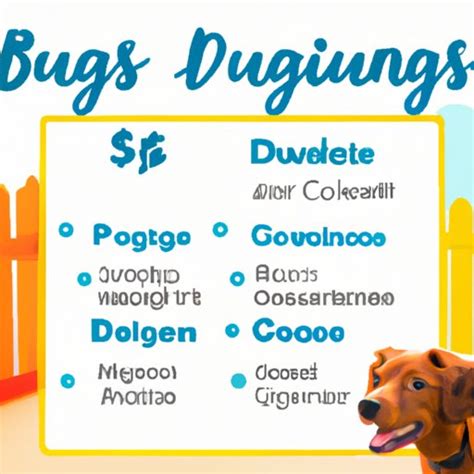Introduction
For millions of Americans, dogs are cherished companions that enrich lives and provide unconditional love. However, becoming a dog parent poses significant financial responsibilities. This article will explore the intricate relationship between dog parenting and budgeting, empowering you to make informed decisions while ensuring both your furry friend’s well-being and your own financial stability.

Financial Costs of Dog Ownership
Understanding the potential costs associated with dog ownership is crucial. According to the American Pet Products Association, the average yearly expense for a dog in the United States is estimated to be $1,631, a figure that can fluctuate depending on factors such as breed, size, location, and lifestyle.
Essential Expenses
- Food and water: $200-$700 per year
- Veterinary care: $200-$1,000 per year (including vaccinations, checkups, and potential treatments)
- Grooming: $50-$200 per year
Additional Expenses
- Training: $50-$500 (one-time or ongoing, depending on the dog’s needs)
- Toys and accessories: $50-$300 per year
- Pet insurance: $50-$100 per month
- Boarding or pet-sitting: $20-$60 per day (if necessary when traveling or working)
Budgeting Strategies for Dog Owners
Accommodating the financial demands of dog parenting requires careful budgeting. Here are some effective strategies:
- Create a dedicated dog budget: Allocate a specific amount of money each month for dog-related expenses.
- Prioritize essential costs: Ensure that your dog’s basic needs, such as food, veterinary care, and grooming, are met before allocating funds to non-essential items.
- Consider pet insurance: Unexpected veterinary expenses can put a strain on your budget. Consider purchasing pet insurance to cover potential medical costs.
- Explore cost-saving options: Look for affordable food options, discounts on grooming services, and free or low-cost training classes.
- Make lifestyle adjustments: Reduce spending on non-essential items to free up funds for dog-related expenses.
Balancing Needs and Wants
The challenge of dog parenting often lies in striking a balance between meeting your dog’s needs and indulging in wants. While it’s essential to provide adequate resources for your furry companion’s health and well-being, it’s also important to set realistic limits to avoid overspending.
- Needs: Food, water, veterinary care, grooming, training
- Wants: Designer clothing, gourmet treats, expensive toys
Conclusion
Dog parenting is a rewarding but financially demanding endeavor. By understanding the associated costs, implementing effective budgeting strategies, and carefully considering the balance between needs and wants, you can ensure that you provide both your dog and your wallet with the care they deserve. As responsible dog parents, it’s essential to remain vigilant and make informed decisions to ensure the well-being of our beloved companions while maintaining our financial security.
Additional Tips for Dog Parenting on a Budget
- Adopt from a shelter: Adoption fees are significantly lower than purchasing a dog from a breeder.
- DIY grooming: Basic grooming tasks, such as brushing and nail trimming, can be done at home.
- Homemade meals: Preparing your dog’s food can save substantial amounts of money compared to commercial dog food.
- Negotiate discounts: Ask your veterinarian about potential discounts for multiple pets or regular visits.
- Consider pet fostering: Fostering dogs can provide companionship and reduce the financial burden of pet ownership while also helping dogs in need.
Frequently Asked Questions (FAQs)
Q1: How much should I budget for my dog each month?
A1: As a starting point, aim to allocate around $100-$200 per month for essential expenses, with additional funds for non-essential items as your budget allows.
Q2: What is the best way to save money on dog ownership?
A2: Explore cost-saving options such as adopting from a shelter, DIY grooming, homemade meals, and negotiating discounts.
Q3: Should I get pet insurance for my dog?
A3: Pet insurance can provide peace of mind and financial protection in case of unexpected veterinary expenses. Consider your financial situation and the potential risks associated with your dog’s breed and lifestyle.
Q4: How can I balance my dog’s needs with my budget?
A4: Prioritize essential expenses and consider alternative options for non-essential items. Explore ways to reduce spending on other areas of your life to free up funds for your dog’s well-being.
Q5: Is it possible to have a dog on a tight budget?
A5: Yes, it is possible to provide a happy and healthy life for your dog on a limited budget. By implementing creative cost-saving strategies and seeking support from local resources, you can enjoy the companionship of a furry friend without breaking the bank.
Future Trends and Innovations in Dog Ownership
The future of dog ownership is characterized by advancements in technology and a growing emphasis on pet health and well-being. Here are some potential trends:
- Smart feeders and water dispensers: Devices that monitor food and water consumption, alerting owners to potential health issues.
- Virtual veterinary consultations: Remote access to veterinary care, reducing the need for in-person visits.
- Pet-friendly technology: Home appliances and gadgets designed to improve pets’ lives, such as interactive toys and self-cleaning litter boxes.
- Personalized pet care: Tailored diets, training plans, and healthcare regimens based on individual pet data.
By embracing these trends and innovations, dog parents can enhance the bond with their furry companions while ensuring their well-being and managing their budget effectively.





















